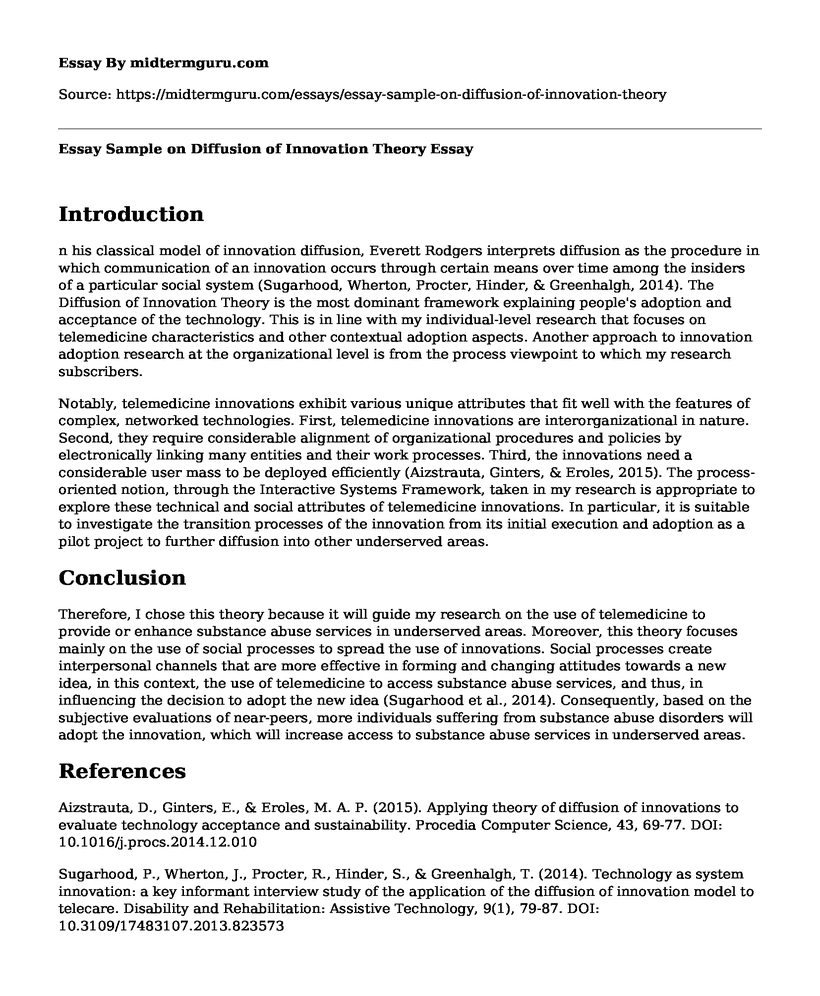Introduction
n his classical model of innovation diffusion, Everett Rodgers interprets diffusion as the procedure in which communication of an innovation occurs through certain means over time among the insiders of a particular social system (Sugarhood, Wherton, Procter, Hinder, & Greenhalgh, 2014). The Diffusion of Innovation Theory is the most dominant framework explaining people's adoption and acceptance of the technology. This is in line with my individual-level research that focuses on telemedicine characteristics and other contextual adoption aspects. Another approach to innovation adoption research at the organizational level is from the process viewpoint to which my research subscribers.
Notably, telemedicine innovations exhibit various unique attributes that fit well with the features of complex, networked technologies. First, telemedicine innovations are interorganizational in nature. Second, they require considerable alignment of organizational procedures and policies by electronically linking many entities and their work processes. Third, the innovations need a considerable user mass to be deployed efficiently (Aizstrauta, Ginters, & Eroles, 2015). The process-oriented notion, through the Interactive Systems Framework, taken in my research is appropriate to explore these technical and social attributes of telemedicine innovations. In particular, it is suitable to investigate the transition processes of the innovation from its initial execution and adoption as a pilot project to further diffusion into other underserved areas.
Conclusion
Therefore, I chose this theory because it will guide my research on the use of telemedicine to provide or enhance substance abuse services in underserved areas. Moreover, this theory focuses mainly on the use of social processes to spread the use of innovations. Social processes create interpersonal channels that are more effective in forming and changing attitudes towards a new idea, in this context, the use of telemedicine to access substance abuse services, and thus, in influencing the decision to adopt the new idea (Sugarhood et al., 2014). Consequently, based on the subjective evaluations of near-peers, more individuals suffering from substance abuse disorders will adopt the innovation, which will increase access to substance abuse services in underserved areas.
References
Aizstrauta, D., Ginters, E., & Eroles, M. A. P. (2015). Applying theory of diffusion of innovations to evaluate technology acceptance and sustainability. Procedia Computer Science, 43, 69-77. DOI: 10.1016/j.procs.2014.12.010
Sugarhood, P., Wherton, J., Procter, R., Hinder, S., & Greenhalgh, T. (2014). Technology as system innovation: a key informant interview study of the application of the diffusion of innovation model to telecare. Disability and Rehabilitation: Assistive Technology, 9(1), 79-87. DOI: 10.3109/17483107.2013.823573
Cite this page
Essay Sample on Diffusion of Innovation Theory. (2022, Sep 26). Retrieved from https://midtermguru.com/essays/essay-sample-on-diffusion-of-innovation-theory
If you are the original author of this essay and no longer wish to have it published on the midtermguru.com website, please click below to request its removal:
- Essay on Nonverbal Communication During the Negotiation Process
- Paper Example on Social Change
- Article Analysis Essay on Culture as a Social Determinant of Mental and Behavioral Health
- Essay Sample on Race and Inclusion in Academic Fields/Majors
- Freedom of Speech: Right to Express Without Restriction - Research Paper
- Exploring Research Elements: Background, Problem, Literature, Summary & Methodology - Essay Sample
- Family Get-Together: Celebrating Credibility & Purpose - Essay Sample







